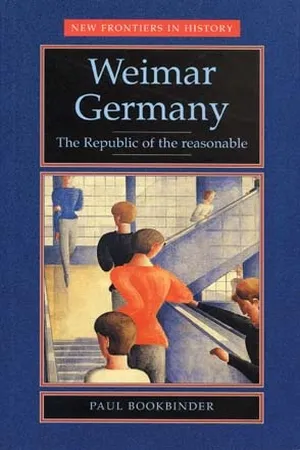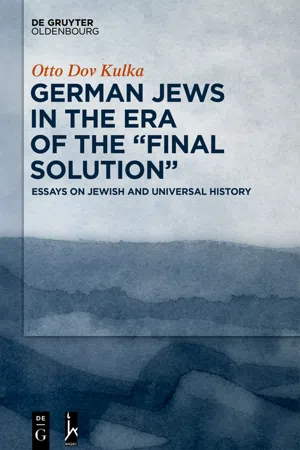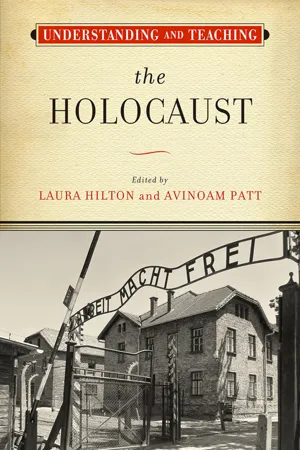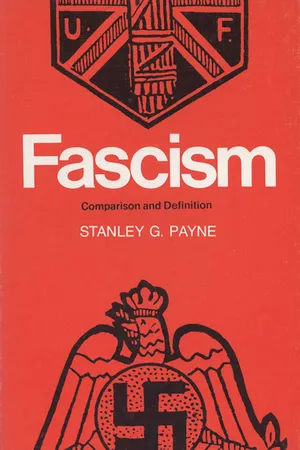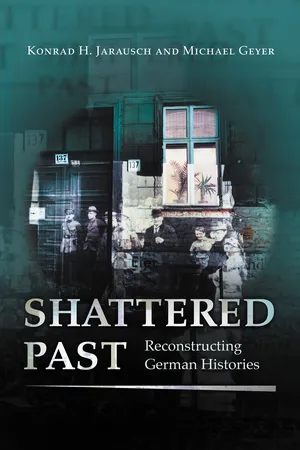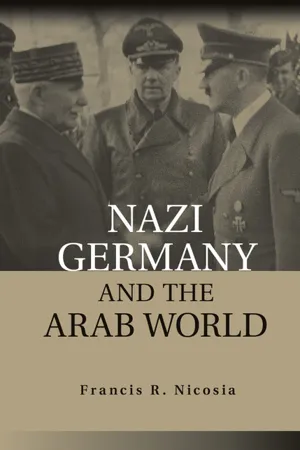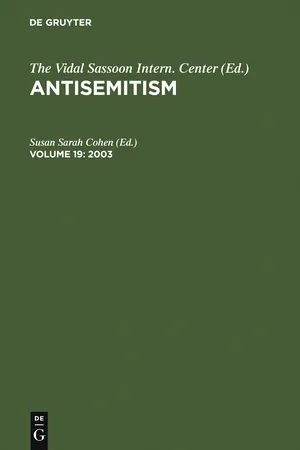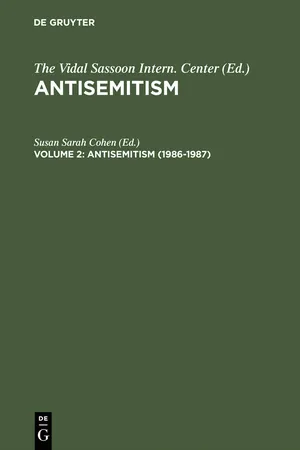History
Nazi Germany
Nazi Germany refers to the period from 1933 to 1945 when Adolf Hitler and the Nazi Party held power in Germany. This era was characterized by totalitarian rule, aggressive expansionism, and the implementation of racist and anti-Semitic policies that led to the Holocaust and the deaths of millions of people. The regime's impact on global history and its atrocities continue to be studied and remembered.
Written by Perlego with AI-assistance
Related key terms
1 of 5
11 Key excerpts on "Nazi Germany"
- eBook - PDF
Weimar Germany
The republic of the reasonable
- Paul Bookbinder(Author)
- 2024(Publication Date)
- Manchester University Press(Publisher)
The contraction of the first parts of the first two words created the term "Nazi" which became the popular name for the party and for its leader's guiding principles. The street comer orator who spoke in Munich in 1919 and the dic- tator of Germany who died in his bunker in Berlin in 1945 had the same goals and the same view of the world. Predicated on a para- noid sense that Germany was surrounded by enemies, Hitler's plan called for a Germany restored to "Great Power" status, able to expand militarily and attain the Lebensraum (living space) that the dynamic, creative German people required and deserved. To succeed he would need to solve the "Jewish problem" which 211 Weimar Germany threatened to destroy the German people. The fledgling National Socialist Party initially attracted young men, many of whom were war veterans, who either had never had a place in the civilian economy and society or could not fit back into their former places. As a result of their war experiences, many of these men had become violent and took their bitterness and anger into the streets on behalf of their new political party. They were organized into auxiliary paramilitary units designed to provide a public show of strength and security for party speak- ers and to threaten and harass opponents. Their initial SA (Sturmabteilung) and subsequent SS (Schutzstaffel) units were duplicated by other political parties including the Communists and the Social Democrats. However, the Nazi paramilitary orga- nizations were much closer to the heart of the party than were those of other groups. Most of the early leaders of the Nazi Party, such as Heinrich Himmler and Alfred Rosenberg who would stay with Hitler until the end, also came from unimpressive backgrounds and lacked the standard prerequisites for success. An exception to this pat- tern was Hermann Goring, air ace and war hero with connections by marriage to the aristocracy. - eBook - PDF
German Jews in the Era of the "Final Solution"
Essays on Jewish and Universal History
- Otto Dov Kulka(Author)
- 2019(Publication Date)
- De Gruyter Oldenbourg(Publisher)
The final years of the Weimar Republic, during which Germany was hard hit by the global economic crisis, were marked by the rise of the National Socialist party. Just before the crisis broke out in 1928, the Nazis won only three percent of the vote; however, in the first elections that took place during the crisis in Sep-tember 1930, their share jumped to 18 percent, and in July 1932 to 37 percent of the vote. With 230 members in the Reichstag , the Nazis became the largest party—and retained that position in the next elections in November 1932, despite a drop to 33 percent of the vote and 196 Reichstag members. During those years, antisemitism came to have a profound effect on Jewish life. It was one of the central elements in the Nazi party’s violent struggle for power, and its effect on the Jews was not confined to physical violence (dese-crations of synagogues and Jewish cemeteries, and even attacks on individual Jews). Nazi political propaganda succeeded in making the “Jewish question” into a major issue in the Nazi struggle against the democratic regime. As a result, not only was the position of the Jews in German society impaired, but many of them underwent a crisis of Jewish consciousness and began to reexamine their Jewish identity. 18 1 German Jewry under the National Socialism in Historical Perspective From 1933 to 1938 In January 1933, on the eve of Hitler’s rise to power, the Jewish population of Germany (including the Saar district, which two years later was reincorporated into Germany) numbered 522,000 Jews by religion; under the racist criteria estab-lished by the Nazis, which were to form the basis of their persecution of the Jews and to find formal expression in racist legislation, the number of Jews by race was 566,000. On January 30, President Paul von Hindenburg appointed Hitler Reich chancellor. - Available until 16 Nov |Learn more
The Holocaust in Eastern Europe
At the Epicenter of the Final Solution
- Waitman Wade Beorn(Author)
- 2018(Publication Date)
- Bloomsbury Academic(Publisher)
9 2 The Origins of the Nazi State Introduction The German Reich, as a State, should include all Germans, not only with the task of collecting from the people the most valuable stocks of racially primal elements and preserving them, but also to lead them, gradually and safely, to a dominating position. ADOLF HITLER, Mein Kampf (1923) 1 Before we can examine the Nazi genocidal project in the East and the unfold-ing of the Holocaust, we must understand the basic history of Nazism. Specifically, how did the Nazi party become the Nazi state and how did this regime come to be in a position to carry out its policies in Eastern Europe? This entails meeting Adolf Hitler, the man, and the organization he created. For, it is Hitler who wrote above how important the East was to the Nazis. Simultaneously, we must be careful not to ascribe to Hitler a master plan or sole responsibility for the Holocaust. The Nazis created a state based on a variety of popular causes that appealed to a broader audience and bought together different constituencies. Hitler built a cult of personality around himself in which he and the state were one—an idea that energized many German people. Territorial expansion was a critical plank in the Nazi platform . . . one which Hitler believed could only be realized in Eastern Europe. He was not alone in this belief either, drawing upon a long history of yearning for a German “return” to the East. This chap-ter brings us to 1939, the point when the Nazis began that return to the East. The Nazi Rise to Power National Socialism must, in principle, claim the right to force its principles on the whole German nation and to educate it in its ideas and thoughts . . . THE HOLOCAUST IN EASTERN EUROPE 30 0 It must determine and reorder the life of a nation, and therefore must imperiously demand for itself the right to overlook boundaries drawn by a tendency which we have rejected. - eBook - PDF
- Laura Hilton, Avinoam Patt, Laura Hilton, Avinoam Patt(Authors)
- 2020(Publication Date)
- University of Wisconsin Press(Publisher)
A common conception is that Hitler and the Nazis sim- ply took advantage of the conditions of defeat in World War I and the terms of the Treaty of Versailles, compounded by economic depression 33 Spicka / The Rise of Nazism in the early 1930s, making the triumph of the Nazi political movement appear almost inevitable. Furthermore, the uncritical use of Nazi propa- ganda itself in documentaries helps cultivate the incorrect impression that somehow the German public was brainwashed or passively fol- lowed the charismatic leadership of Hitler. A related common miscon- ception among students is that all of the Germans were rabid antisemites who recognized and applauded a future goal of the elimination of Jews from German life, if not outright extermination. These depictions of the German electorate obscure crucial dynamics explaining Nazi electoral success and also hinder drawing out some of the larger implications of the rise of the Nazis for us today. The simplest but ultimately unsatisfying answer to why the Nazis came to power is that a plurality of Germans decided to vote for them. The question then is why this happened. Undoubtedly, the political, economic, and social conditions of postwar Germany created a toxic environment of resent- ment and disappointment. However, a key point for students to under- stand is that rarely do voters act purely in negation or reaction against something, but that any successful political party must speak effec- tively to the aspirations and desires of the electorate. Pedagogical Challenges and Questions In the context of a class on the Holocaust, the challenge for the teacher is how to approach the interplay of various factors and contexts that are most important to explain why the German people put into power a regime that sought to tear down the democratic system in which it operated. Clearly, the conclusion of World War I and terms of the peace are a critical, but not a complete, explanation for the rise of Hitler. - eBook - PDF
A History of Modern Germany
1800 to the Present
- Martin Kitchen, Lauren Faulkner Rossi(Authors)
- 2023(Publication Date)
- Wiley-Blackwell(Publisher)
In spite of fierce political resistance, the exigencies of a terrible war were such that women gained a degree of independence that was to fuel their demand for further emancipation in the post-war years. National Socialism and Modernity Nazi Germany was so irredeemably awful that it took many years before serious scholars could ask the question whether there was anything positive about it. In 1965 the sociologist Ralf Dahrendorf presented the startling thesis that the twelve years of Nazi dictatorship had provided the impetus for a surprising degree of modernization. Two years later David Schoenbaum went one stage further by claiming that here had been a “brown revolution,” resulting in a fundamental change of mental and social structures. These ideas were either rejected or ignored by historians for at least twenty years, to be revisited when a rather unfruitful and agitated debate began about modernization. This soon got bogged down in a theoretical muddle, caused by methodological inadequacies and the sheer impossibility of applying a theory designed to reveal long-term trends to a period of a mere twelve years. Some questioned whether it was possible to talk meaningfully of a “society” when for half the time one-fifth of the population was at war and one-tenth were virtually slaves. Millions of “racial Germans” in the east were uprooted and resettled in the “Great German Reich.” Eighteen million served in the armed forces from Narvik to North Africa, from Brest to Baku. The National THE NAZI DICTATORSHIP TO 1939: POLITICS, SOCIETY, CULTURE 245 Socialists did what they could to destroy the familiar class structure with their ideology of the “racial community” in which class divisions were to be replaced by racial discrimination, with the Aryans offered equal opportunities, all dutifully serving the common cause under a charis- matic leader. - eBook - PDF
Fascism
Comparison and Definition
- Stanley G. Payne(Author)
- 1980(Publication Date)
- University of Wisconsin Press(Publisher)
(Pittsburgh, 1969-73); Peter Diehl-Thiele, Partei und Staat im Dritten Reich (Munich, 1969); Martin Broszat, Der Staat Hitlers (Munich, 1969); H. Mommsen, Beamtentum im Drit- ten Reich (Stuttgart, 1966); Peter Hiittenberger, Die Gauleiter (Stuttgart, 1969); and H. Matzerath, Nazionalsozialismus und kommunale Selbstverwaltung (Stutt- gart, 1970). THE MUSSOLINI AND HITLER REGIMES I 95 state in the Reichsreform of 1934-36,40 and may also under- estimate the actual role of the NSDAP in German administra- tion. On the local level the party did tend to take over the state to some degree, and gauleiters became district state of- ficials in a process sometimes the reverse of what happened in Italy. Moreover, local party leadership began to play an increased role during the war, so that by the fmal years the party leadership had indeed largely taken over the home front. Finally, the major parapolitical and administrative role of the SS steadily expanded this elite branch of Nazi power during the last phase of the regime. 41 For much of the generation after the war, the concept of totalitarianism held vogue, likening Nazi Germany to the So- viet Union, however, much more than to Italy. The defini- tion of totalitarianism has always been remarkably vague, and the most recent fad has been to deny that any such thing existed or exists. Since theorists of totalitarianism rarely get beyond such rudimentary and limited qualities as the single party, the use of terror, and mass mobilization, it is easy to argue either that many different kinds of regimes are total- itarian or conversely that none of them is perfectly total. Yet the concept of totalitarianism is both valid and useful if defined in the precise and literal sense of a state system that attempts to exercise total control over all significant aspects of all major national institutions, from the economy and armed forces to the judicial system, the churches, and cul- ture. - eBook - PDF
Germany, 1871-1945
A Concise History
- Raffael Scheck(Author)
- 2008(Publication Date)
- Berg Publishers(Publisher)
Jews were not allowed to sit down on park benches, to use swimming pools, to go shopping except during certain hours, and much more. Life became progressively difficult for Germany’s Jews. Jews were encouraged to emigrate but not forced to do so. The Nazi regime set up Jewish committees that prepared Jews for emigration to Palestine, but the British authorities ruling Palestine, mindful of escalating Arab resentment against Jewish immigration, were unwilling to admit a large number of German Jews. Prospects to obtain a visa to another country were not much better because many countries still suffered from the effects of the Great Depression and were unwilling to admit Jews. It took much patience, money, and (often) foreign connections to emigrate. Those Jews who did manage to leave sometimes became the target of anti-German resentment in their host countries. The policies of exclusion Nazi Germany, 1933–9 • 171 of unwanted “racial” groups and the efforts to “purify” the German race drastically escalated during the war, but, except for the discrimination against Jews, they were not yet prominent to a degree that would have made many Germans feel threatened by the regime before the war. The persecution of the Jews met with some approval, much indifference, and some mumbled disapproval. The most successful aspect of the Nazi regime, aside from overcoming the Great Depression, was its foreign policy. Within five years, Hitler and his aides managed to rearm Germany, to dismantle almost all of the remaining legacy of the Treaty of Versailles, and to turn Germany into a strong, even hegemonic, power in Central Europe. This seemed like a spectacular success, and it made Hitler more popular than ever before in Germany. - eBook - PDF
Shattered Past
Reconstructing German Histories
- Konrad H. Jarausch, Michael Geyer(Authors)
- 2009(Publication Date)
- Princeton University Press(Publisher)
6 Ian Kershaw, The Nazi Dictatorship: Problems and Perspectives of Interpretation (London, 1993); Ju ¨ rgen Kocka, ed., Historische DDR-Forschung. Aufsa ¨tze und Studien (Berlin, 1993). 7 The term is from Klaus-Michael Mallmann and Gerhard Paul, Herrschaft und Alltag: Ein Industrierevier im Dritten Reich (Bonn, 1991), 327 ff. 8 Hannah Arendt, The Origins of Totalitarianism , 3rd ed. (New York, 1973), 305 ff. T O T A L I T A R I A N T E M P TAT I O N 1 5 1 of the nobility and the Großbu ¨ rgertum resorted to populist countermo-bilization strategies of acclamation, Bonapartism, and manipulation from above. 9 At the same time, the desire of the poor and exploited for greater prosperity and security necessitated an expansion of the role of government by reducing economic risks and regulating social changes. This clamor for increased public assistance, when amplified by aca-demic reformers, led to the establishment of a social service bureau-cracy that produced an “authoritarian welfare state,” trading paternal-ist aid for political acquiescence. 10 Competing attempts at conceptualization, inspired by the subse-quent contest between dictatorship and democracy, might offer a theo-retical starting point for solving this puzzle. Already during 1933 Klemperer “equated National Socialism and Communism: both are materialist and tyrannical, both disregard and negate intellectual and personal freedom.” 11 After World War I, political theorists who were fascinated by these similarities of both dictatorships developed the concept of “totalitarianism” to account for the novelty in the extent and methods of repression. 12 During the 1970s liberal analysts, seeking to soften the German division, proposed a less judgmental comparison between various policies of the Communist and the western demo-cratic systems so as to analyze their actual functioning. - eBook - PDF
- Francis R. Nicosia(Author)
- 2014(Publication Date)
- Cambridge University Press(Publisher)
It points to the regime’s tendency to improvise when the facts on the ground necessitated an unwelcome and temporary move in a particular direction, and to do so primarily in the regime’s wartime propaganda to the Arab world. In the end, therefore, this study argues that the Arab-Nazi relationship between 1933 and the end of the Second World War, from the perspective of Hitler and his Nazi state, was and remained “ideologically and strategically incompatible.” 36 Given their the frustration, resentment, and hostility toward the post–World War I settlement in the Middle East, many Arab leaders and intellectuals greeted the new regime in Germany with enthusiasm early in 1933. 37 As observed in Chapter 1, some Arab leaders had informed German officials in the immediate post–World War I years that Germany, unlike Great Britain, France, and Italy, was never an object of suspicion and hostility in the Arab world given the general perception among Arabs that Germany had never had colonial ambitions in the region. There were also some Arabs who sought to identify themselves with National Socialism, particularly with the Nazi move- ment’s perceived discipline, order, national solidarity, strength, and political success. That some identified as well with Nazi hatred and persecution of the Jews in Germany was likely a reflection of their bitter opposition to the Jewish National Home and Jewish immigration into Palestine as well. All of this tended to promote the hope among some Arabs that Germany, as a “neutral bystander” in the postwar Middle East, might be a potential source of active support against the western powers and the Jewish National Home. The nationalist fervor of the Nazis, and their determination to eliminate the postwar settlement in Europe held considerable appeal for some Arabs who considered the mandate system a cover for an extended European imperial 35 Ibid., 68. - eBook - PDF
2003
Antisemitism
- Susan Sarah Cohen(Author)
- 2012(Publication Date)
- De Gruyter Saur(Publisher)
As a German nationalist, Schlatter accepted the Aryan paragraph which led to the expulsion of Jewish converts from the Church. Like the Nazis, he regarded the Jews as Germany's main social problem, but he expressed his views in non-racist terms. While he was not a purveyor of Nazi ideology, and was certainly not guilty of eliminationist antisemitism, his theological attacks against 1919-1945: Europe: Germany 191 Judaism bolstered antisemitism amongst the populace, and ultimately promoted a passive acceptance of the Holocaust. DR 0480 Meyer zu Uptrup, Wolfram: Kampf gegen die juedische Weltver-schwoerung: Propaganda und Antisemitismus der Nationalsozialisten 1919 bis 1945. Berlin: Metropol, 2003. 560 pp. Based on the author's diss. - Technische Universitaet Berlin, 1998. The concept of the German Volksgemeinschaft and its deadly enemy, world Jewry, was central to the ideology of Hitler and his followers. The Jewish conspiracy could explain the First World War, the German defeat, the Russian Revolution, the economic crisis, and the Judenrepublik, all part of a plot to destroy Germany and all of Western civilization and to rule the world, as set forth in the Protocols of the Elders of Zion. The ideology was not new, but Hitler added a call for action: the Volksgemeinschaft was to become a Kampfgemeinschaft, a fighting community, to save Germany and the world. The enemy was the Jew in all his forms: Bolshevist, plutocrat, democrat, Freemason. The idea was propagated in the party's organ Der Voelkische Beobachter, the SS's Das schwarze Korps, and other Nazi publications, and in the speeches of all the Nazi leaders. The agitation was somewhat subdued in the first years of the Nazi regime, but revived with preparations for total war. Again the Jews, who purportedly pulled the strings in all the Allied governments, were blamed for the war. Since they allegedly meant to destroy Germany, it was not only just but vital to destroy them first. - eBook - PDF
- Susan Sarah Cohen(Author)
- 2015(Publication Date)
- De Gruyter Saur(Publisher)
The basis of antisemitism and all totalitarian ideologies is a demand for the absolute, which produces and justifies final solutions. AA 0612 Marrus, Michael R. The History of the Holocaust: A Survey of Recent Literature. JOURNAL OF MODERN HISTORY 59, 1 (Mar 1987) 114-160. Surveys the intentionalist-functionalist historians' debate and Gerald Fleming's attempt to prove that Hitler personally ordered the extermination of the Jews (see Vol. 1, no. 511). Argues that many important Nazi decisions resulted from mandates issued by Hitler as his personal wish rather than as decrees or laws. The latest edition of Hilberg's work (see above, no. 589) maintains that the machinery of destruction was the driving force and Hitler served as a distant inspiration. Recent studies on local popular attitudes suggest indifference to the Jews' fate, whereas other historians describe German society as preoc-cupied with the Jewish question. Examines the reflection of changes in Nazi policy in different countries, and the share in responsibility of Poles, Hungarians, and the organized Jewish leadership for the fate of the Jews. LF 0613 Marrus, Michael R. Population Movements in Eastern Europe and the Final Solution. REFUGE 5, 2 (Dec 1985) 3-7. Summarizes Hitler's policy of Lebensraum - to settle Germans in the East, and to clear the territory fron Poles and Jews who would be employed in forced labor and eventually eliminated. Shows how this policy led to the implementation of the Final Solution. SSC 0614 May, Derwent. HANNAH ARENDT. Harmondsworth, Middlesex: Penguin Books, 1986. 139 pp. (Lives of Modern Women) 1919-1945: General 209 A short biographical portrait of Hannah Arendt. Mentions her writing on Jewish subjects and her work in fighting Nazism during the 1930s. Describes her attempt to explain Nazi genocide in The Origins of Totalitarianism (1951).
Index pages curate the most relevant extracts from our library of academic textbooks. They’ve been created using an in-house natural language model (NLM), each adding context and meaning to key research topics.
